Text
Take it with a grain of salt because trail cam footage at night can be a bit tricky to figure out, but I believe this is a particularly angry American marten (Martes americana)!
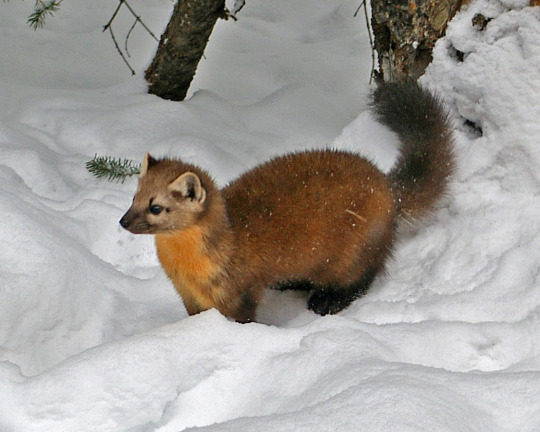
They call me pillsbury the way that I’m a doe boy
25K notes
·
View notes
Text
Almost! That’s an Hispaniolan solenodon (Solenodon paradoxus), one of the two living species of solenodons, only found in the island of Hispaniola in the Caribbean! You’re thinking of its closest and only relative, the Cuban solenodon (Atopogale cubana):

Picture by @the_zoologist_barista on Instagram
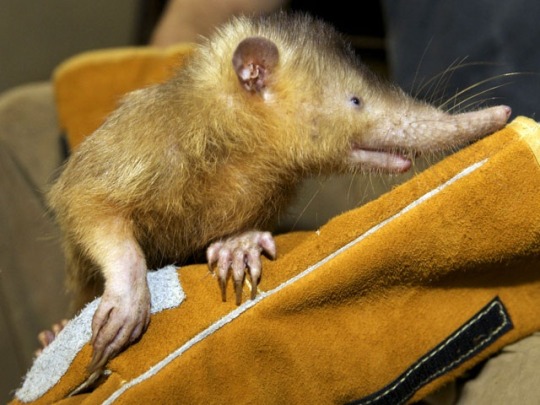
i am attracted to the color of your jacket and i am from Cuba
2K notes
·
View notes
Text
Not to be confused with the fisher cat, also known as just fisher (Pekania pennanti).

These guys are a good example of when an animal’s common name is a little bit misleading: not only they’re mustelids and not cats, they also don’t swim or eat fish all that often! They’re very good climbers, though:
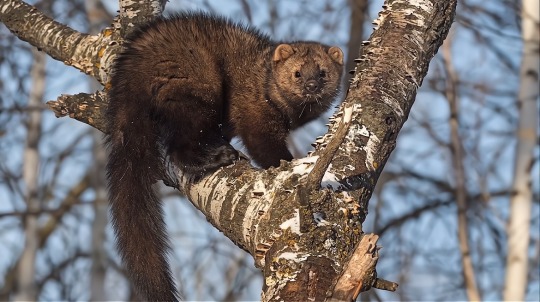
Photo by @ctfishandwildlife on Instagram

For those of you who wisely avoid Facebook have this excellent image from the San Antonio Zoo page.
29K notes
·
View notes
Text
Fishing cat (Prionailurus viverrinus), a wild cat species from Asia. They’re only a little bigger than domestic cats and, as their name implies, they primarily feed on fish and are very skilled swimmers!

Photo by @discoverindia.magazine on Instagram

For those of you who wisely avoid Facebook have this excellent image from the San Antonio Zoo page.
29K notes
·
View notes
Text

All members of the mammalian order Monotremata lay eggs instead of giving birth to live young! Excluding subspecies, there are five of them: the platypus (Ornithorhynchus anatinus), the short-beaked echidna (Tachyglossus aculeatus), the eastern long-beaked echidna (Zaglossus bartoni), the western long-beaked echidna (Zaglossus bruijnii) and the now confirmed Attenborough's long-beaked echidna (Zaglossus attenboroughi).
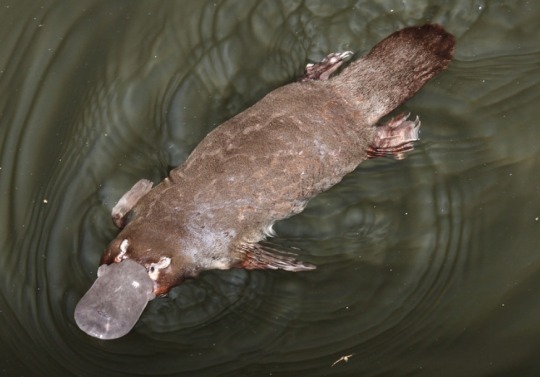
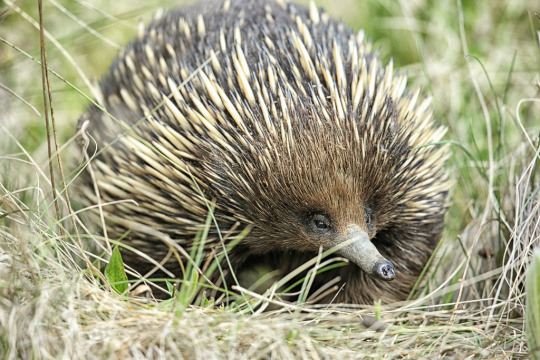
Pictured: platypus and short-beaked echidna.
But to be more specific, monotremes are the only surviving order of mammals to still lay eggs instead of giving live birth. That’s because they split from marsupial and placental mammals very early on, so they kept a couple of odd traits we don’t usually see in modern mammals, one of them being laying eggs. At the beginning, though, all mammals laid eggs! It just so happens that, other than monotremes, the ones we have today are all descendants of a single mammal that learned One Easy Hack to not have to lay eggs anymore (growing a placenta).
Other unusual traits of monotremes are having cloacas, venomous spurs and, despite having mammary glands, both males and females lacking nipples altogether. Their milk comes out of ducts in their skin, much like sweat does in humans.

https://abcnews.go.com/US/scientists-confirmed-existence-200-million-year-species-thought/story?id=122773046&cid=social_twitter_abcn
#well it was probably a little more complicated than that#we’ve probably had more than one viral infection cause placenta-like effects#but it was such an OP mutation it just stuck around!
2K notes
·
View notes
Text


https://abcnews.go.com/US/scientists-confirmed-existence-200-million-year-species-thought/story?id=122773046&cid=social_twitter_abcn
2K notes
·
View notes
Text
*: it’s kind of debatable whether animals raised for their pelts are truly domestic, with the argument being that domestication comes first and foremost as selective breeding for a milder temperament, with traits differing them from their wild counterparts appearing later and, in the case of fur farms, animals are bred for coat color, density, texture and such over temperament.
That being said… us humans kind of select friendlier animals out of instinct. Like, even in the most hands-off sorts of animal rearing, we have to handle them eventually. Besides, by this logic, goldfish and koi wouldn’t be domestic animals either. Either way, a sable adopted from a fur farm is very likely much more chill than a wild one, but they’re no kitty cats. Much less dogs. We have yet to replicate what we’ve done with dogs. They’re pretty unique!
Usually I’m not super fond videos of wild animals being kept as pets, but just like certain other animals such as raccoon dogs and foxes, sables are farmed for their fur in certain parts of the world, so I believe it’s way more likely that the little guy in the video was adopted from a fur farm rather than snatched from the wild.
Animals from fur farms also tend to be much tamer and less avoidant of humans than they’d be in the wild*, which also points towards the sable we’re looking at not being a wild animal but rather the product of several generations of animals raised in captivity. But I do hope that their owner provides them with lots of enrichment and/or supervised access to more outdoorsy environments, though. They probably still have very different needs than, say, your average ferret.
#I had no scale for just how dogs are uniquely wired for understanding humans until l adopted middle-eastern village dogs.#They're very much like like Carolina Dogs or New Guinea Singing Dogs in behavior.#Some are *almost* like regular dogs.#Some avoid eye contact entirely. Some won't even wag their tails. Feels almost uncanny valley-ish.#I still love them though. They're my prehistoric buddies.
199 notes
·
View notes
Text
Usually I’m not super fond videos of wild animals being kept as pets, but just like certain other animals such as raccoon dogs and foxes, sables are farmed for their fur in certain parts of the world, so I believe it’s way more likely that the little guy in the video was adopted from a fur farm rather than snatched from the wild.
Animals from fur farms also tend to be much tamer and less avoidant of humans than they’d be in the wild*, which also points towards the sable we’re looking at not being a wild animal but rather the product of several generations of animals raised in captivity. But I do hope that their owner provides them with lots of enrichment and/or supervised access to more outdoorsy environments, though. They probably still have very different needs than, say, your average ferret.
199 notes
·
View notes
Text
Sable (Martes zibellina)! Sables are an Eurasian species of martens. They're arboreal mustelids whose closest relatives are wolverines, tayras and fisher cats.
You know... even thought I always knew mustelids were caniformes (as in, carnivorans more closely related to canids rather than felids) l've personally always thought that martens were more feline than canine in appearance, what with their climbing skills and triangular ears and whatnot. Upon watching this video, though, l'd like to formally retract this sentiment: that's the most doggy sound I've ever heard coming from an animal who's most definitely not a dog!
30K notes
·
View notes
Text
Least pygmy squirrel (Exilisciurus exilis) and I lowkey find them cool because they’re really really small like smaller than all the other squirrels and even house mice but its ok we all have different opinions and I think theyd say yes if we offered them long necks for better plant (and bug) eating
this things kindof stupid can we give it a long neck so it can reach leaves and eat them

523 notes
·
View notes
Text
One very interesting fact about bush dogs is that the story of their discovery is very similar to the coelacanth’s! The Speothos genus was first identified and described by the Danish-Brazilian zoologist and paleontologist Peter Wilhelm Lund, after he unearthed fossils of a canid dubbed Speothos pacivorus, from caves in Minas Gerais, Brazil, in 1839. As with most other prehistoric species he found and studied, he assumed the Speothos genus was fully extinct.
Three years later, he described a living, previously unknown small canid specimen and placed it in a different genus. The animal was very elusive and rarely sighted at all, let alone captured and studied in depth so, for the next 180 years, was shuffled between nine different genera, until a consensus was finally reached: they were the only other member of the Speothus genus Lund had described all those years ago and still alive and kicking today, unlike their S. pacivorus cousins!
Bush dogs are also the only South American canids to hunt in packs and have partially webbed toes, which makes them pretty decent swimmers.

This picture has already been reposted here on Tumblr by someone else (not the OP of the tweet, as far as I can tell) but they have me blocked on my main and I don’t want to overstep any boundaries. I REALLY wanted to identify this guy, though, so I hunted the original tweet down just for that. That’s a bush dog (Speothos venaticus).
910 notes
·
View notes
Text

This picture has already been reposted here on Tumblr by someone else (not the OP of the tweet, as far as I can tell) but they have me blocked on my main and I don’t want to overstep any boundaries. I REALLY wanted to identify this guy, though, so I hunted the original tweet down just for that. That’s a bush dog (Speothos venaticus).
910 notes
·
View notes
Text
White-bellied pangolin (Phataginus tricuspis)

lets be heavily armored with mama
44K notes
·
View notes
Text
Fossa (Cryptoprocta ferox)

Being nefarious with mama
#AKA the cat-like animals who wanted to eat the lemurs in Madagascar (2005)#mammals#animal identification#fossa
50K notes
·
View notes
Text
Bilby or greater bilby (Macrotis lagotis). Bilbies are small, omnivorous burrowing marsupials with an appearance similar to placental lagomorphs. Due to that and the fact that rabbits are invasive species in Australia, ever since the early 90s Australian candy manufacturers have sold chocolate bilbies as an alternative to chocolate bunnies, with a percentage of their sales usually being donated to wildlife conservation groups.
Some fun facts about bilbies are that their pouches face backwards so that dirt doesn’t get into it when they dig holes and that they have no need to drink water: they get all their hydration from the food they eat!
its dangerous to go alone. here, take these bilbies
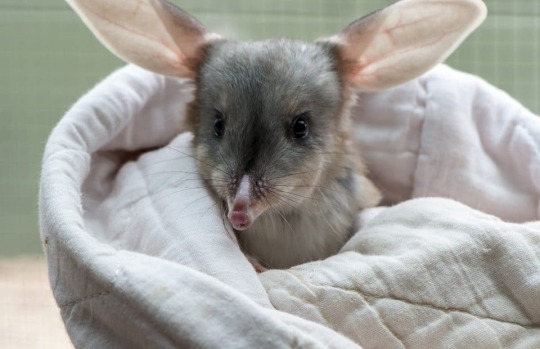
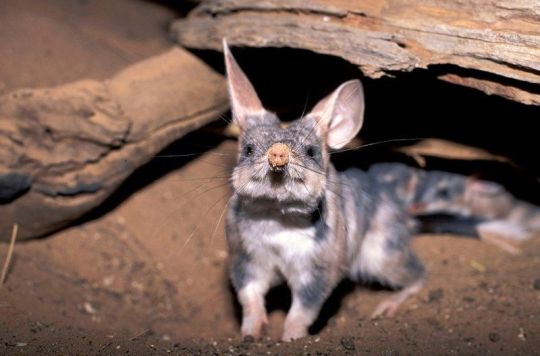
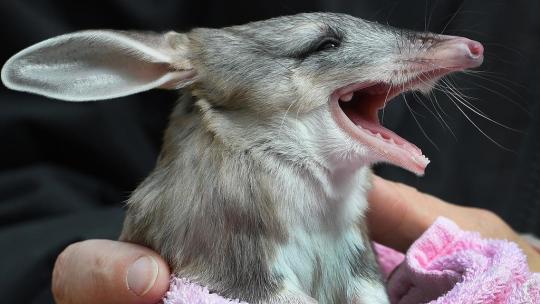
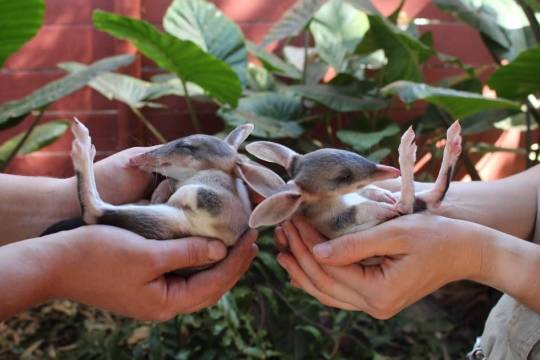
38K notes
·
View notes
Text
Rock hyrax (Procavia capensis). Believe it or not, their closest relatives are elephants and manatees!
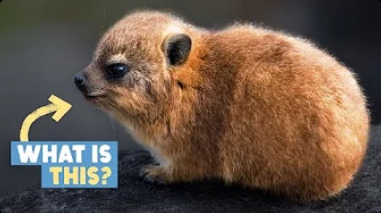
1K notes
·
View notes
Text
Long-eared jerboa (Euchoreutes naso)

got his ass
7K notes
·
View notes